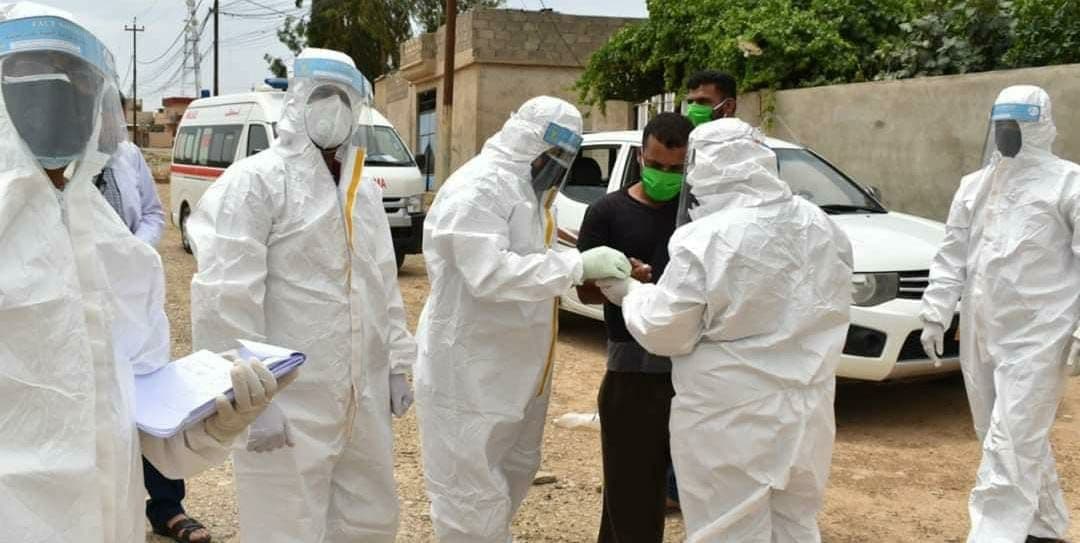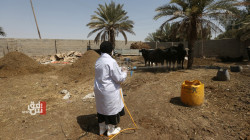Silent threat: Hemorrhagic Fever cases surge in Iraq in 2024

Shafaq News/ A silent but deadly threat lurks beneath the surface of Iraq's war-torn landscape. Hemorrhagic fever, a group of viruses that can ravage the body's systems, is experiencing a worrying surge in 2024.
The menacing disease continues to claim lives and spread across the nation, with Iraqi authorities ramping up their efforts to combat its transmission and protect public health.
Understanding Viral Hemorrhagic Fevers
Viral hemorrhagic fevers (VHFs) are a group of diseases caused by several distinct families of viruses. The term refers to conditions where many of the body's organ systems are affected, the cardiovascular system is damaged, and the body's ability to function independently is reduced.
These viral infections are not limited to a single mode of transmission. They can spread in numerous ways, including through insect bites and contact with the body fluids of infected people or animals.
The viruses in this group range in severity. Many of them cause mild illness, but all can damage the blood vessels and interfere with the blood's ability to clot, leading to life-threatening complications.
Viral hemorrhagic fever (VHF) symptoms vary depending on the specific disease. Early in the illness, they often include fever, body aches, dizziness, extreme tiredness (fatigue), headache, and rash.
In severe cases, VHFs can also cause bleeding from the nose, eyes, gums, or vagina, severe vomiting or diarrhea, vomiting blood, bloody diarrhea, chest, neck, or stomach pain, difficulty breathing, extremely low blood pressure, seizures, and coma.
In Iraq, Crimean-Congo hemorrhagic fever (CCHF) is the most common type.
VHF In Iraq: A Critical Analysis
"We knew Crimean-Congo hemorrhagic fever (CCHF) was present in Iraq decades ago. But comparing the current and historical epidemiological data, we saw that the spread of CCHF was happening faster than usual this time," says Dr Chen Lim, the former MSF's medical coordinator in Iraq.
According to the WHO, Iraq is among the eastern Mediterranean countries where Crimean-Congo Hemorrhagic Fever (CCHF) is endemic. The disease has been documented in Iraq since 1979, when it was first identified in ten patients. Subsequently, six cases were recorded between 1989 and 2009, followed by 11 cases in 2010. In 2018, three fatal cases were reported, and more recently, in 2021, there were 33 confirmed cases, with 13 resulting in death (a case fatality rate of 39%).
Shafaq News Agency contacted the Iraqi Ministry of Health to clarify the latest developments regarding the number of cases and the measures taken. However, the ministry only referred to a "general statement" on the matter.
A study by Zeenah Atwan and others published in 2024 revealed that Crimean-Congo hemorrhagic fever (CCHF) cases surged from 33 in 2021 to 511 by August 2023, signaling a rapid rise.
"Analysis of the CFR among all Iraqi provinces showed differences in the severity of CCHF among the different regions. Baghdad and cities to the north of it displayed the highest CFR among confirmed cases: Erbil 38.5%, Dahuk 25%, Kirkuk 22.2%,…Anbar and Sulaimaniya reported no deaths among confirmed cases."
The World Health Organization (WHO) reported that between January 1 and May 22, 2022, Iraqi health authorities notified WHO of 212 cases of Crimean-Congo Hemorrhagic Fever (CCHF). Of these, 115 (54%) were suspected, and 97 (46%) were laboratory-confirmed; there were 27 deaths, including 14 in suspected cases and 13 in laboratory-confirmed cases. The number of cases reported in the first five months of 2022 is significantly higher than in 2021 when only 33 laboratory-confirmed cases were recorded.
Cases have been reported in several governorates in Iraq, and the outbreak may add pressure to an already over-stretched healthcare system.
In 2024, Iraq recorded 40 cases of viral hemorrhagic fever, including five deaths, according to the Iraqi Ministry of Agriculture.
Dhi Qar governorate reported the highest cases, with 15 infections and two deaths. Nineveh recorded 6 cases and one death, Babil had 4 cases and one death, and Baghdad reported 6 cases and one death. Additionally, Kirkuk announced two new cases.
Causes Of Outbreaks in Iraq
WHO pointed out that sheep and cattle husbandry are prevalent in Iraq, and studies indicate that these animals are frequently infested with ticks, primarily Hylomma species, which serve as the primary vectors for CCHF transmission.
Basim Al-Gharabi, a member of the Parliamentary Health Committee, explained to Shafaq News Agency that the rise in human cases of hemorrhagic fever is linked to temperature fluctuations.
Al-Gharabi explained that "the tick, which carries hemorrhagic fever, goes dormant in winter and becomes active in summer. This leads to cases being reported during this time each season, with an increase higher than usual for the past two years," attributing the disease's activity to "grazing and random animal keeping in the streets, necessitating an awareness campaign and therapeutic measures by the Iraqi Ministry of Health, which has comprehensive information about hemorrhagic fever. The treatment protocol is available, and ticks are eradicated through pesticides, as well as washing and dipping of sheep and other preventive measures."
Comprehensive Prevention Measures
WHO recommended reducing the risk of tick-to-human, animal-to-human, and human-to-human transmission by enforcing relevant preventive measures during slaughtering, butchering, and culling procedures, quarantining animals before they enter slaughterhouses or routinely treating animals with pesticides two weeks before slaughtering them, and ensuring that healthcare workers implement infection prevention control measures when taking care of CCHF cases or other cases presenting with hemorrhagic fever.
UN Iraq conducted workshops in collaboration with Iraqi universities in this regard.
In 2023, the Iraqi Red Crescent Society organized a health awareness campaign on hemorrhagic fever prevention as part of a broader program. This initiative aims to increase community health awareness during the Arbaeeniya pilgrimage, when crowds travel on foot across Iraq and neighboring countries to commemorate Imam Hussein.
Dr. Ali Al-Moussawi, the director of the IRCS health department, mentioned that over 250 volunteers from 8 governorates participated in the campaign. They focused on field meetings and distributed informational materials and personal protective equipment, especially to Husseini procession owners.
Other initiatives were launched in several governorates.
In Diyala, the director of the Veterinary Hospital, Ibtisam Jasim, explained to Shafaq News Agency that a heightened state of alert is necessary to prevent hemorrhagic fever.
Jasim mentioned that 21 veterinary teams patrol daily in the governorate, conducting campaigns to combat and dip livestock, targeting the virus-carrying vector, Hylomma ticks. Additionally, strict measures have been imposed on livestock transportation following veterinary guidelines.
In Karbala, the Veterinary Hospital has outlined measures to be taken in case of hemorrhagic fever, including creating a 15-kilometer containment zone to prevent animal movement in and out of the infected area.
A nationwide free campaign began in Karbala on April 15 and will continue until June 15 to prevent hemorrhagic fever and eliminate its vector, the Hylomma tick. The campaign, which spans two months and covers all districts and regions of Karbala and its livestock breeders, includes spraying and dipping all animals with deltamethrin, an effective treatment for eliminating the tick, the carrier of the disease.
Dr. Wisam Al-Jaberi, the director of the Veterinary Hospital, informed Shafaq News Agency that "Karbala has not reported any cases this year so far due to measures taken by the hospital in collaboration with the local government."
These measures include "forming a crisis cell in coordination with Karbala Operations Command to prevent animals from governorates with reported infections from entering Karbala, monitoring butcher and slaughterhouse activities regarding this disease, and prohibiting random slaughtering while enforcing regulations, leading to the apprehension of many violators."
Al-Jaberi stressed, "Preventive measures will continue until the end of the tick's active period in animals, which lasts from two to three months. Afterward, the tick will disappear, and the number of cases of this disease will decrease."
Abu Mohammed and Abu Ali, two butchers in Karbala, confirmed to Shafaq News that the butchers are following strict measures to inhibit the spread of the virus. These measures include purchasing livestock from reputable sources, ensuring they undergo examination, and slaughtering them within designated areas (slaughterhouses).





